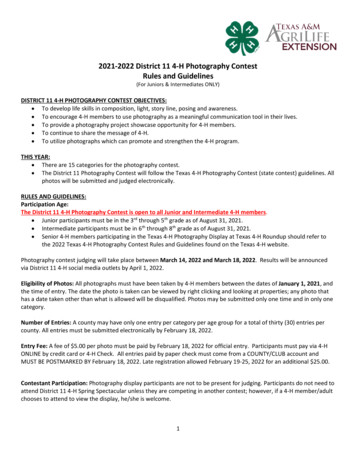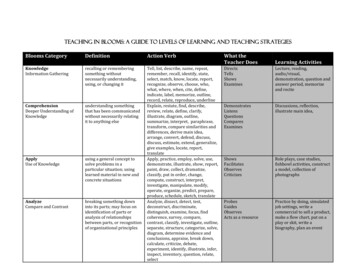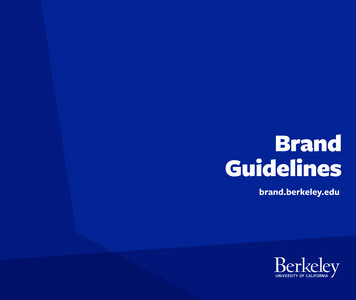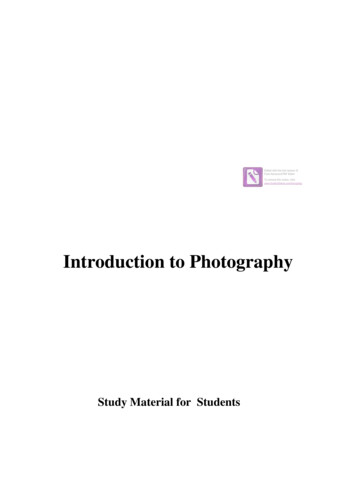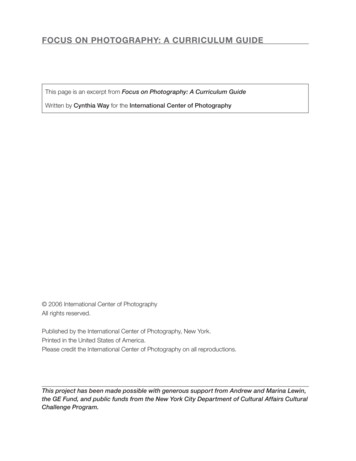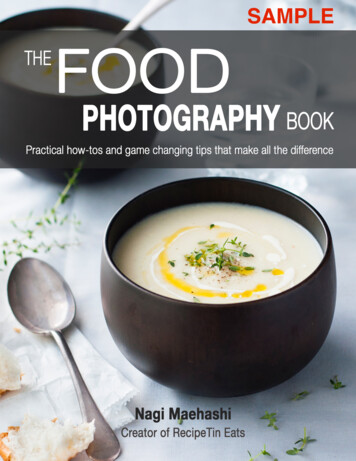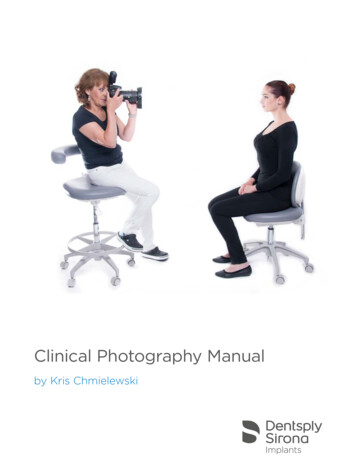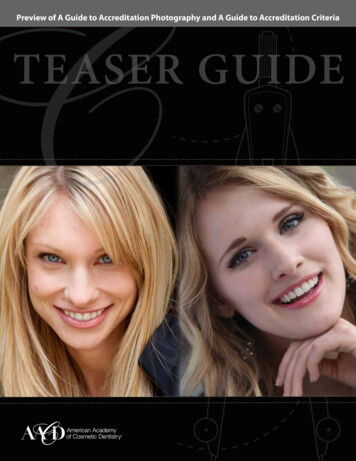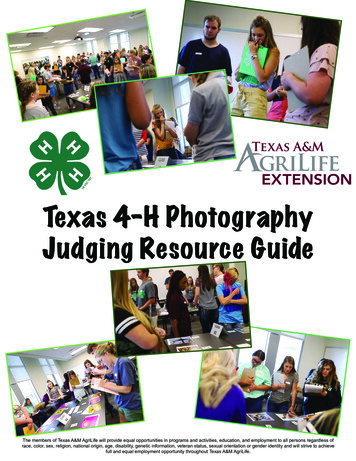
Transcription
Texas 4-H PhotographyJudging Resource GuideThe members of Texas A&M AgriLife will provide equal opportunities in programs and activities, education, and employment to all persons regardless ofrace, color, sex, religion, national origin, age, disability, genetic information, veteran status, sexual orientation or gender identity and will strive to achievefull and equal employment opportunity throughout Texas A&M AgriLife.
Contest Rules and ProceduresRESOURCESThe Beginner’s Photography Guide, 2nd Edition, by Chris Gatcum - Available in bookstores and onlineNational 4-H Photography Curriculum Level 1: Photography Basics - Available in the 4-H Mall at www.shop4-h.orgNational 4-H Photography Curriculum Level 2: Next Level Photography - Available in the 4-H Mall at www.shop4-h.orgNational 4-H Photography Curriculum Level 3: Mastering Photography - Available in the 4-H Mall at www.shop4-h.orgFor practice power points and additional graphy-video/ELIGIBILITY1. All participants must be active Texas 4-H members for the current 4-H year and be aregistered contestant in Texas 4-H Roundup.2. The Texas 4-H Photography Judging Contest is open to all intermediate and senior aged4-H members.3. The invitational contest will be held as part of Texas 4-H Roundup in College Station,Texas.4. Any youth who has completed a post-secondary (university, college, junior college ortechnical school) course related to photography are ineligible to compete in this contest.In addition, any 4-H member that has participated in any post-secondary competitiveevent of a similar nature and in the same subject matter is ineligible to compete in thiscontest.5. Teams will consist of 3 or 4 members. The overall team score shall be determined bytotaling the top three scores of the members. All contestants are eligible for individualawards. Counties can enter more than one team in both the Intermediate and SeniorDivisions of the contest. Individuals can participate in the contest if they are unable toform a county team. Intermediates can compete on Senior teams if their county does nothave enough of one age category to make a complete team.CONDUCT OF CONTESTANTS6. No contestant shall wear any clothing, pins or badges that will in any way reveal his/heridentity, county or club that he/she represents. No hats are to be worn during thecontest.7. All electronic devices (cell phones, pagers, calculators, etc.) are prohibited. Pleaseadvise your contestants to remove these devices prior to the start of the contest. If acontestant's phone should ring, or if they are discovered using such electronic devicesduring the contest, the contestant and their team may be disqualified.8. Contestants may not leave once the contest has started unless permission is given bythe contest superintendent.
9. Contestants should not separate themselves from the class on which their group isworking.10. Contestants should not in any way willfully obstruct the work of another contestant.11. While the contest is in progress, there shall be no talking or any other type ofcommunication between contestants or coaches. If a contestant has a question once thecontest begins, please direct that question to the assigned group leader or the contestsuperintendent.SCORING12. Scan sheets will be provided. Contestants must provide their own #2 pencil and maybring an unmarked clipboard and/or manila folder and a blank piece of paper (lined orunlined) for use during the contest. Forms that are bent or abused will not be scored.13. Ties will be broken using the results of predetermined classes (in order). If ties still exist,ranking with the ties will be the discretion of the contest superintendent(s).RESULTS14. Results, as announced, are final. Contestants, or representatives, must be present toreceive their awards. Any remaining awards will not be mailed following Texas 4-HRoundup.CLASS PROCEDURES15. Contestants will be divided into groups for the contest and will remain with their assignedgroup throughout the contest. Movement of the group to each class will be controlled bythe contest superintendent.16. Classes – 4 minutes will be allowed for each class. Contestants will be given a warningof 1 minute before time is up.17. Photos in the contest will be designated left to right as 1, 2, 3, and 4.18. No oral reasons for this contest.CLASSESMaximum PointsPer ClassTotal PointsPossible6 photographyjudging classes503002 photo problemsclasses50100Possible IndividualScore400Judging classes can consist of photographs from the categories of people, animals, plant/flora,nature/landscape, special/digital effects, night photography, black & white, animals (domestic or
wildlife), details/macro, architecture, or other categories as deemed by the contest committeeand judges.Photography problem classes will cover such things as exposure, ISO, shutter speed, focallength, white balance, camera settings, composition, technique, photo shooting situations, andother questions as deemed necessary by the contest committee and judges. The official judgingrubric for the Texas 4-H Photography contest should be used as a resource for the photographyjudging contest.AWARDSAwards will be presented to the 1st to 10th Intermediate and Senior individuals and teams.Contest ResourcesTop tips:1. Follow the rubric from the Texas 4-H Photography Contest when evaluating the photos.2. Stay subjective: Don’t let your personal bias get in the way of seeing the photo for its’true quality.3. Balance your judging between the technical aspects of the photo and thecreativity/impact of the photo.4. Allow yourself to take as long as you need in the allotted 4 minutes.5. Turn your back from the photos after making your placing to avoid second guessingyourself.6. Look at all of the photos together before inspecting them individually to establish thequality range of the photos (i.e. 4 poor photos vs. 4 high quality photos, 2 high qualityand 2 poor photos, etc.)7. Clear your mind of subject prejudice- evaluate the photo, not the subject.8. Stick to your guidelines and what you’ve practiced.9. Positives attributes negative attributes total evaluationQuestions to ask yourself about the photo on first look: Does the photo clearly belong in the category? If not, place it last. For example: a photoof an adult in a category marked “Children”. Does the picture capture the eye? Is the photo special? Does the photo look at the subject in a new way? How does the image make you feel?When determining technicality, consider: Lighting: is it under or over exposed? Was there a proper use of natural or created light? Composition: Is the photo properly composed; was the photographer shooting at theright angle for the best shot? Leading lines: Do the lines in the image draw your eye to the focal point? Framing: Did the photographer use aspects of the image to frame the focal point?
Movement into space: Does the focal point of the image have space to move within thephoto or is it moving toward the edge of the photo?White balance: What is the balance of color in the photo?Foreground/background mergers: Is the subject roughly the same color as theforeground or background? Can you determine the focal point from the backgroundnoise?
Texas 4-H Photography ContestScore SheetName:Category:County:You are competing against standards of excellence outlined below, not against your peers. Before preparing your entry for submission please carefullyreview the judging criteria. Based on total points awarded for each photograph, the participant will be awarded either a blue, red, white, or a participation ribbon.JUDGES, PLEASE INDICATE POINTS AWARDED IN FAR RIGHT COLUMN:CATEGORYPOINTRANGEJUDGING ELEMENTImpact(Max Points: 15)Creativity(Max Points: 15)Technical(Max Points: 25)Composition(Max Points: 20)Subject Matter(Max Points: 15)Story Telling(Max Points: 10)Impact is the sense one gets upon viewing an image for the first time.Compelling images evoke laughter, sadness, anger, pride, wonder oranother intense emotion. There can be impact in any of the judgingelements.0-15Creativity is the original, fresh, and external expression of the imaginationof the maker by using the medium to convey an idea, message or thought.0-15Technical is the quality of the image itself as it is presented for viewing,which includes the following aspects: allowable amounts of retouching and adjustments (removal of red eye,cropping, minor straightening) sharpness and correct color balance. lighting, which includes the use and control of light. The use of lightingwhether natural or man-made and its proper use to enhance the image. posing and capturing of the image.0-25Composition is important to the design of an image, bringing all of thevisual elements together in concert to express the purpose of the image.Proper composition holds the viewer in the image and prompts the viewerto look where the creator intends. Effective composition can be pleasingor disturbing, depending on the intent of the image maker.0-20Subject Matter should always be appropriate to the story being told (i.e.category the photo is entered into) in an image. Subject matter alsoincludes the center of interest for the photograph or where the makerwants the viewer to stop and they view the image.0-15Story Telling refers to the image’s ability to evoke imagination. Onebeautiful thing about art is that each viewer might collect his ownmessage or read her own story in an image.0-10POINTSAWARDEDTOTAL POINTS AWARDEDAWARD(circle one)Blue Award(100 points to 81 pts)JUDGES COMMENTS:Red Award(80 to 51 pts)White Award(50 to 31 pts)Participant Award(30 to 0 pots)
Contest Rules and Procedures RESOURCES The Beginner’s Photography Guide, 2nd Edition, by Chris Gatcum - Available in bookstores and online National 4-H Photography Curriculum Level 1: Photography Basics - Available in the 4-H Mall at www.shop4-h.org National 4-H Photography Curriculum Level 2: Next Level
